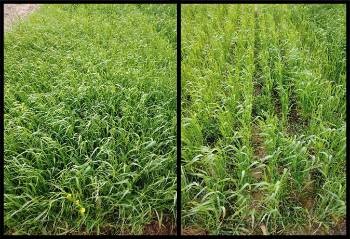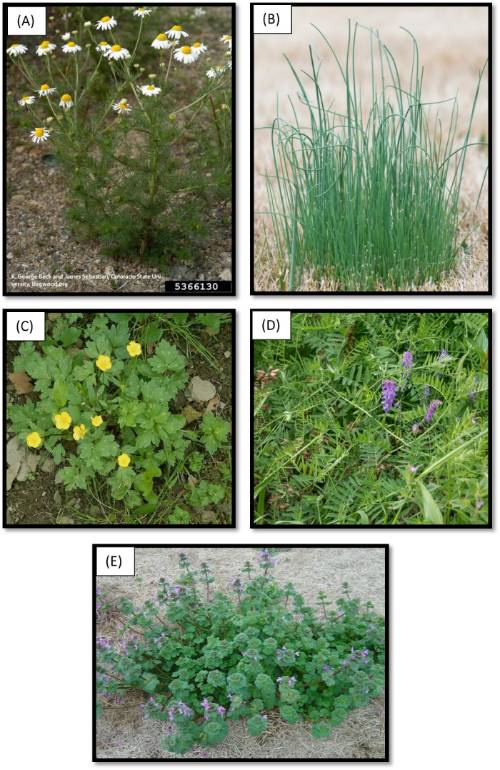Managing Your Weeds in Wheat this Spring
Managing Your Weeds in Wheat this Spring
By: Tommy Butts, Extension Weed Scientist and Jason Kelley, Wheat & Feed Grains Extension Agronomist
Some favorable grain prices has led to a slight increase in wheat acres across Arkansas for 2021. The National Agriculture Statistics Service Acreage Report earlier this week indicated that Arkansas producers planted 180,000 acres of wheat during the fall of 2020. Questions regarding weed control recommendations have been rolling in. Italian ryegrass is by far the most troublesome and requires the most effort to successfully manage; however, annual bluegrass (Poa annua) and winter annual broadleaves also present some challenges.
Italian ryegrass is a highly competitive weed species with prolific growth characteristics and adaptability that makes it a challenging weed to manage. Additionally, it has evolved herbicide resistance to ALS-inhibitors (PowerFlex HL, Osprey), ACCase-inhibitors (FOPS, Axial XL), and glyphosate in Arkansas. Italian ryegrass has also been unofficially confirmed resistant to the ACCase-inhibitor, clethodim (Select Max) in areas of south Arkansas. Therefore, it is necessary to know your ryegrass population and appropriately select effective herbicide options to manage it POST in wheat (Fig. 1). ALS-inhibitor resistance in ryegrass is extremely common across Arkansas (>65% of populations tested have been confirmed resistant) so typically herbicides such as PowerFlex HL and Osprey are not considered good control options. Pinoxaden (Axial) resistance, although confirmed in the state, has been much less prevalent (~20% of populations tested were confirmed resistant). Therefore, the best option for spring control of Italian ryegrass is to apply Axial Bold at 15 fl oz/ac when it is actively growing (at least 7 days of temperatures above 55°F). Be aware, if broadleaves are also present, Axial Bold has no activity on broadleaves and should not be tank-mixed with 2,4-D as efficacy will be reduced. If a broadleaf herbicide tank-mix partner is needed with Axial Bold, Harmony Extra and Quelex are good options. For more information on Italian ryegrass ID, resistance, and control, please see FSA2191 Management of Italian Ryegrass in Agronomic Crops.

In addition to Italian ryegrass, there are numerous winter annual broadleaf weeds that may pop up such as mayweed, buttercup, hairy vetch, henbit, and wild garlic/onion (Fig. 2). PowerFlex HL, 2,4-D, Quelex, Harmony Extra, Express, and Peak are all good options for managing these broadleaf weeds. Please see the Wheat section (pg. 83) of the 2021 MP44 Recommended Chemicals for Weed and Brush Control for specific recommendations regarding the best herbicide option and rate for each of these weeds dependent on your field scenario. Horseweed has also shown to be problematic in our wheat acres. Quelex (0.75 oz/ac) or 2,4-D (1.5 pt/ac) will provide the greatest control.

Another problematic grass weed species we’ve received a couple of phone calls on is annual bluegrass (Poa annua). If wheat has a good stand and canopy, POST herbicide control options may not always be economical, but if the wheat has a poor stand, limited growth, or has been grazed by geese, a herbicide application may be required. There are limited options to successfully manage Poa in wheat this time of year if metribuzin or Zidua was not applied in the fall. The best option for control is Osprey at 4.75 oz/ac; however, expect control to be slow. Additionally, make sure to follow label recommendations for adjuvants to maximize the effectiveness; typically, 3 lb/ac of ammonium sulfate (AMS) plus 0.25% v/v NIS is recommended.
Applications of any spring herbicides in wheat should be applied around green-up, which is typically in February/early March. This allows herbicides, especially systemic ones, to be more effective on weeds that are actively growing and early enough to still apply to small weeds.
If you have any questions regarding spring weed control in wheat, please don’t hesitate to reach out to either of us. Good luck out there!
|
Tommy Butts Extension Weed Scientist (501) 804-7314 |
Jason Kelley Wheat & Feed Grains Extension Agronomist (501) 749-6207 |